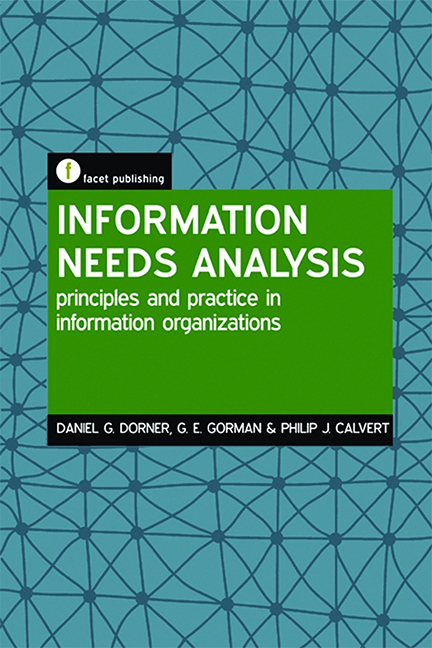Book contents
- Frontmatter
- Contents
- List of figures and tables
- List of scenarios
- About the authors
- Preface
- 1 Background to needs analysis for information managers
- 2 The importance of context in information needs analysis
- 3 Models and types of information needs analysis
- 4 The stages of information needs analysis
- 5 Gathering data for information needs analyses
- 6 Gathering data from existing sources
- 7 Gathering data through surveys
- 8 Gathering data through interviews
- 9 Analysing and integrating information needs analysis data
- 10 Reporting on an information needs analysis
- Bibliography
- Index
6 - Gathering data from existing sources
Published online by Cambridge University Press: 10 September 2022
- Frontmatter
- Contents
- List of figures and tables
- List of scenarios
- About the authors
- Preface
- 1 Background to needs analysis for information managers
- 2 The importance of context in information needs analysis
- 3 Models and types of information needs analysis
- 4 The stages of information needs analysis
- 5 Gathering data for information needs analyses
- 6 Gathering data from existing sources
- 7 Gathering data through surveys
- 8 Gathering data through interviews
- 9 Analysing and integrating information needs analysis data
- 10 Reporting on an information needs analysis
- Bibliography
- Index
Summary
Introduction
This chapter provides guidance on using existing data in INAs. Existing data can be obtained from a wide variety of sources and can take many different forms. In some INAs the gathering of new information might not be required because enough data already exist. In many INAs the investigators will use existing information to establish the background and context as the first step in their planning. And, bearing in mind the complexities as well as the staffing and other costs involved in employing the quantitative and qualitative methods described in Chapters 7 and 8, using existing data can be an effective and efficient approach for conducting all or part of an INA.
Useful INA data can be found in such existing resources as published statistics documents from government agencies and professional associations, from local sources such as chambers of commerce and in internal administrative forms and records, including those generated by computer systems. The wide variety of existing data is reflected in the many uses to which they are applied in INAs. In some instances the data can be very recent, whereas in others data can go back over a lengthy period of time. As a result, existing data can be what is sometimes referred to as historical data, and an investigator might be required to undertake some historical research for all or part of an INA. For example in the chapter ‘Historical Investigation’ in Gorman and Clayton's Qualitative Research for the Information Professional, Shep points out that ‘historical data on an information service's evolving client service priorities may be essential as a basis for decisions concerning services to, say, particular ethnic groups in a multicultural social context’ (Shep, 2005, 161).
The benefit of using existing data in a needs analysis requires little explanation. Data created within an organization (or community) can tell us much about the nature of the organization itself, for example: the way the organization sees itself through its mission, objectives, products and services; its clients; the way communication takes place within the organization; and what it values.
- Type
- Chapter
- Information
- Information Needs AnalysisPrinciples and Practice in Information Organizations, pp. 113 - 138Publisher: FacetPrint publication year: 2017



